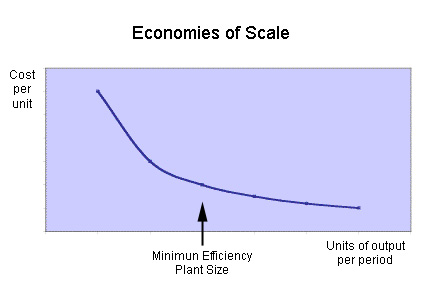The first part of this series (click here to read) explained that there are basically two types of competitive advantage: cost advantage and differentiation advantage. For the next few posts we will cover all the sources that can create a cost advantage for a company.
Economies of scale represent the classic source of cost advantage. It basically refers to a situation where a firm can decrease the average cost per unit by increasing the total output. Economies of scale is also equivalent to an increase returns to scale situation, meaning that if we increase the inputs by X% the outputs will consequently increase by more than X%.

Notice that economies of scale are present mainly in industries that operate with large fixed costs in the production process (i.e. Steel, automobiles and petrochemicals), and they are strongly connected to the degree of concentration in such industries.
There are 3 main factors creating economies of scale:
1. Specialization: Large companies are able to breakdown the production into smaller and separated tasks, employing the resources more efficiently. This efficiency comes both from the specialized workforce and from the specialized equipment and manufacturing processes.
2. Bargaining Power: As organizations grow they gain bargaining power with suppliers. If a certain company doubles the amount of raw materials it is buying every month it will very likely be able to negotiate better prices.
3. Indivisibility of Resources: Some resources are not divisible and can not be purchased or operated under certain thresholds. Research facilities and advertising campaigns, for instance, require a minimum size.
Comments are closed.